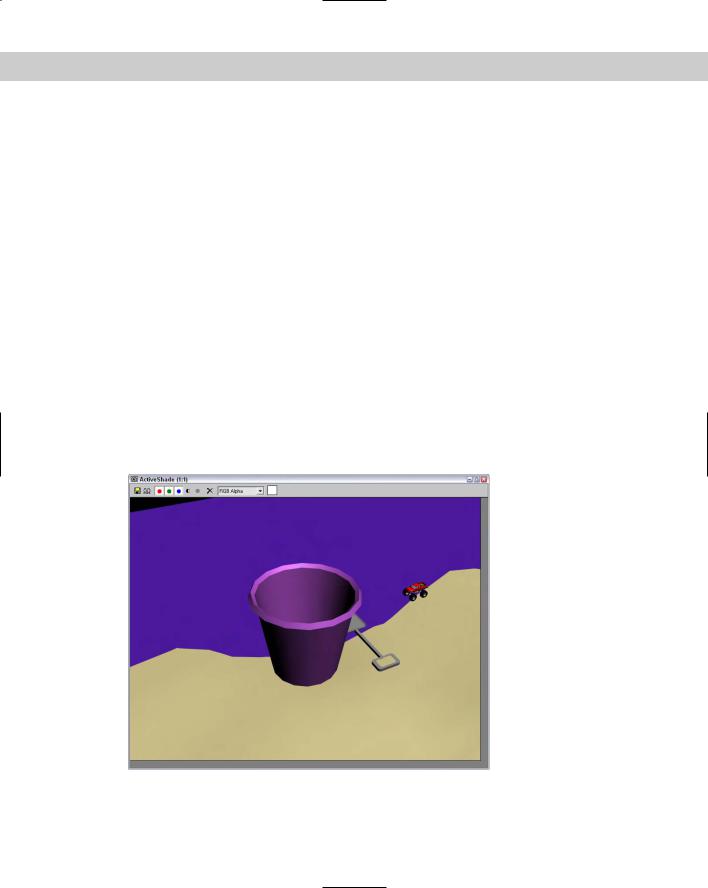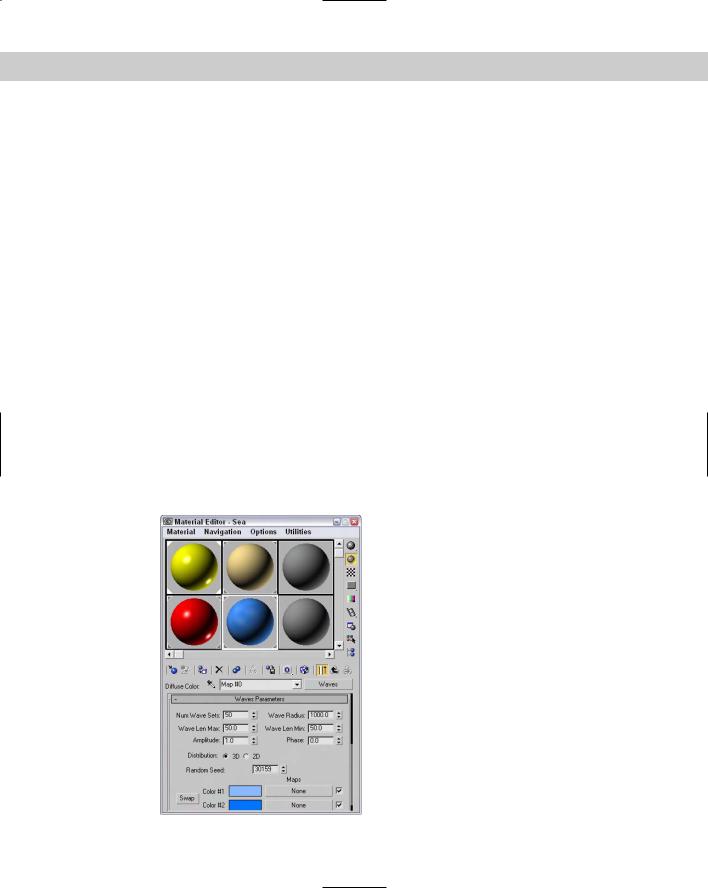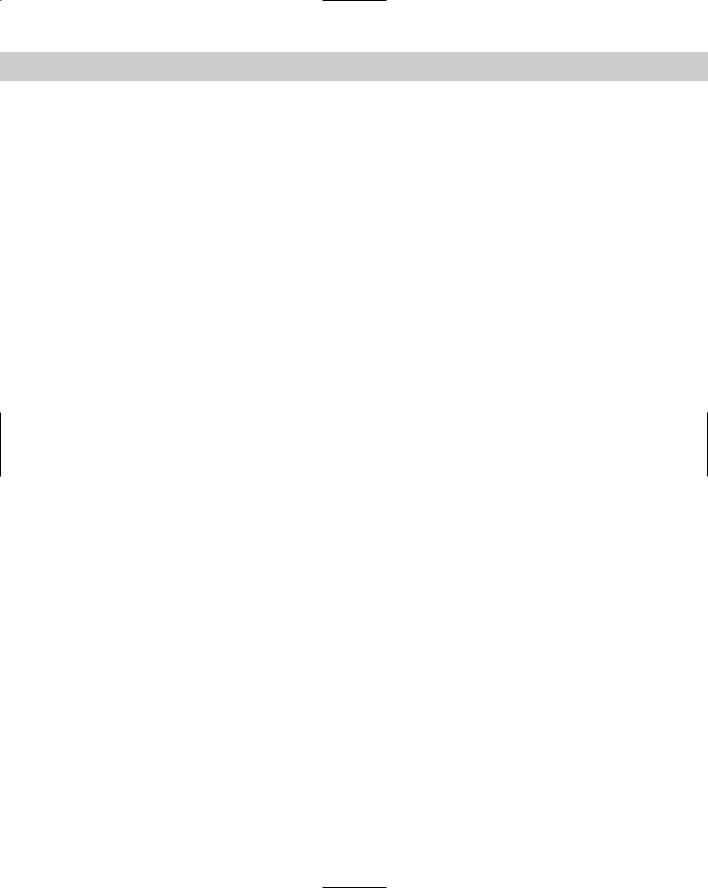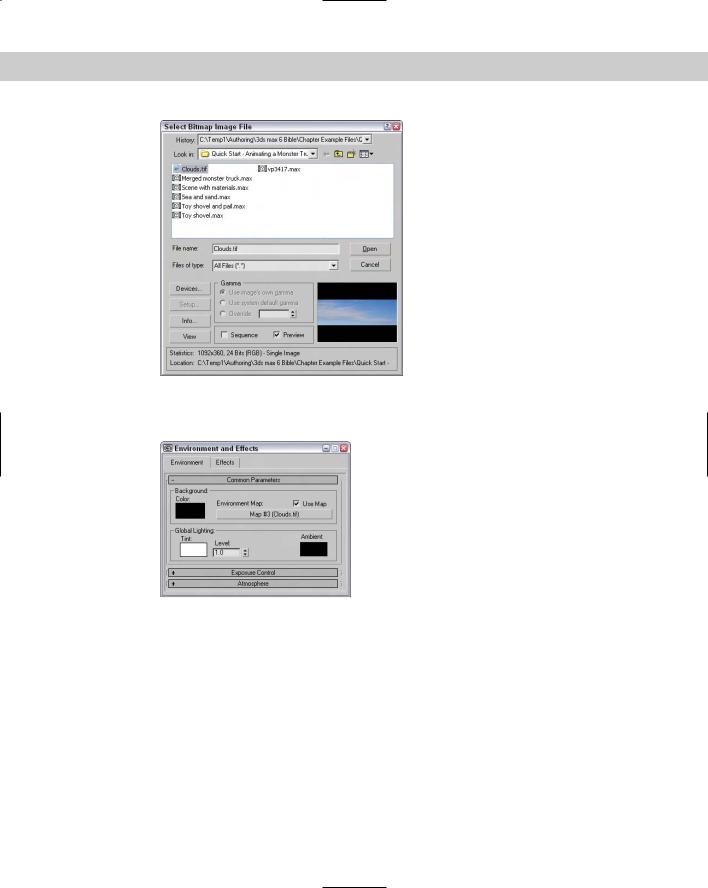
- •Preface
- •About This Book
- •Acknowledgments
- •Contents at a Glance
- •Contents
- •Relaxing at the Beach
- •Dressing the Scene
- •Animating Motion
- •Rendering the Final Animation
- •Summary
- •The Interface Elements
- •Using the Menus
- •Using the Toolbars
- •Using the Viewports
- •Using the Command Panel
- •Using the Lower Interface Bar Controls
- •Interacting with the Interface
- •Getting Help
- •Summary
- •Understanding 3D Space
- •Using the Viewport Navigation Controls
- •Configuring the Viewports
- •Working with Viewport Backgrounds
- •Summary
- •Working with Max Scene Files
- •Setting File Preferences
- •Importing and Exporting
- •Referencing External Objects
- •Using the File Utilities
- •Accessing File Information
- •Summary
- •Customizing Modify and Utility Panel Buttons
- •Working with Custom Interfaces
- •Configuring Paths
- •Selecting System Units
- •Setting Preferences
- •Summary
- •Creating Primitive Objects
- •Exploring the Primitive Object Types
- •Summary
- •Selecting Objects
- •Setting Object Properties
- •Hiding and Freezing Objects
- •Using Layers
- •Summary
- •Cloning Objects
- •Understanding Cloning Options
- •Mirroring Objects
- •Cloning over Time
- •Spacing Cloned Objects
- •Creating Arrays of Objects
- •Summary
- •Working with Groups
- •Building Assemblies
- •Building Links between Objects
- •Displaying Links and Hierarchies
- •Working with Linked Objects
- •Summary
- •Using the Schematic View Window
- •Working with Hierarchies
- •Setting Schematic View Preferences
- •Using List Views
- •Summary
- •Working with the Transformation Tools
- •Using Pivot Points
- •Using the Align Commands
- •Using Grids
- •Using Snap Options
- •Summary
- •Exploring the Modifier Stack
- •Exploring Modifier Types
- •Summary
- •Exploring the Modeling Types
- •Working with Subobjects
- •Modeling Helpers
- •Summary
- •Drawing in 2D
- •Editing Splines
- •Using Spline Modifiers
- •Summary
- •Creating Editable Mesh and Poly Objects
- •Editing Mesh Objects
- •Editing Poly Objects
- •Using Mesh Editing Modifiers
- •Summary
- •Introducing Patch Grids
- •Editing Patches
- •Using Modifiers on Patch Objects
- •Summary
- •Creating NURBS Curves and Surfaces
- •Editing NURBS
- •Working with NURBS
- •Summary
- •Morphing Objects
- •Creating Conform Objects
- •Creating a ShapeMerge Object
- •Creating a Terrain Object
- •Using the Mesher Object
- •Working with BlobMesh Objects
- •Creating a Scatter Object
- •Creating Connect Objects
- •Modeling with Boolean Objects
- •Creating a Loft Object
- •Summary
- •Understanding the Various Particle Systems
- •Creating a Particle System
- •Using the Spray and Snow Particle Systems
- •Using the Super Spray Particle System
- •Using the Blizzard Particle System
- •Using the PArray Particle System
- •Using the PCloud Particle System
- •Using Particle System Maps
- •Controlling Particles with Particle Flow
- •Summary
- •Understanding Material Properties
- •Working with the Material Editor
- •Using the Material/Map Browser
- •Using the Material/Map Navigator
- •Summary
- •Using the Standard Material
- •Using Shading Types
- •Accessing Other Parameters
- •Using External Tools
- •Summary
- •Using Compound Materials
- •Using Raytrace Materials
- •Using the Matte/Shadow Material
- •Using the DirectX 9 Shader
- •Applying Multiple Materials
- •Material Modifiers
- •Summary
- •Understanding Maps
- •Understanding Material Map Types
- •Using the Maps Rollout
- •Using the Map Path Utility
- •Using Map Instances
- •Summary
- •Mapping Modifiers
- •Using the Unwrap UVW modifier
- •Summary
- •Working with Cameras
- •Setting Camera Parameters
- •Summary
- •Using the Camera Tracker Utility
- •Summary
- •Using Multi-Pass Cameras
- •Creating Multi-Pass Camera Effects
- •Summary
- •Understanding the Basics of Lighting
- •Getting to Know the Light Types
- •Creating and Positioning Light Objects
- •Viewing a Scene from a Light
- •Altering Light Parameters
- •Working with Photometric Lights
- •Using the Sunlight and Daylight Systems
- •Using Volume Lights
- •Summary
- •Selecting Advanced Lighting
- •Using Local Advanced Lighting Settings
- •Tutorial: Excluding objects from light tracing
- •Summary
- •Understanding Radiosity
- •Using Local and Global Advanced Lighting Settings
- •Working with Advanced Lighting Materials
- •Using Lighting Analysis
- •Summary
- •Using the Time Controls
- •Working with Keys
- •Using the Track Bar
- •Viewing and Editing Key Values
- •Using the Motion Panel
- •Using Ghosting
- •Animating Objects
- •Working with Previews
- •Wiring Parameters
- •Animation Modifiers
- •Summary
- •Understanding Controller Types
- •Assigning Controllers
- •Setting Default Controllers
- •Examining the Various Controllers
- •Summary
- •Working with Expressions in Spinners
- •Understanding the Expression Controller Interface
- •Understanding Expression Elements
- •Using Expression Controllers
- •Summary
- •Learning the Track View Interface
- •Working with Keys
- •Editing Time
- •Editing Curves
- •Filtering Tracks
- •Working with Controllers
- •Synchronizing to a Sound Track
- •Summary
- •Understanding Your Character
- •Building Bodies
- •Summary
- •Building a Bones System
- •Using the Bone Tools
- •Using the Skin Modifier
- •Summary
- •Creating Characters
- •Working with Characters
- •Using Character Animation Techniques
- •Summary
- •Forward versus Inverse Kinematics
- •Creating an Inverse Kinematics System
- •Using the Various Inverse Kinematics Methods
- •Summary
- •Creating and Binding Space Warps
- •Understanding Space Warp Types
- •Combining Particle Systems with Space Warps
- •Summary
- •Understanding Dynamics
- •Using Dynamic Objects
- •Defining Dynamic Material Properties
- •Using Dynamic Space Warps
- •Using the Dynamics Utility
- •Using the Flex Modifier
- •Summary
- •Using reactor
- •Using reactor Collections
- •Creating reactor Objects
- •Calculating and Previewing a Simulation
- •Constraining Objects
- •reactor Troubleshooting
- •Summary
- •Understanding the Max Renderers
- •Previewing with ActiveShade
- •Render Parameters
- •Rendering Preferences
- •Creating VUE Files
- •Using the Rendered Frame Window
- •Using the RAM Player
- •Reviewing the Render Types
- •Using Command-Line Rendering
- •Creating Panoramic Images
- •Getting Printer Help
- •Creating an Environment
- •Summary
- •Creating Atmospheric Effects
- •Using the Fire Effect
- •Using the Fog Effect
- •Summary
- •Using Render Elements
- •Adding Render Effects
- •Creating Lens Effects
- •Using Other Render Effects
- •Summary
- •Using Raytrace Materials
- •Using a Raytrace Map
- •Enabling mental ray
- •Summary
- •Understanding Network Rendering
- •Network Requirements
- •Setting up a Network Rendering System
- •Starting the Network Rendering System
- •Configuring the Network Manager and Servers
- •Logging Errors
- •Using the Monitor
- •Setting up Batch Rendering
- •Summary
- •Compositing with Photoshop
- •Video Editing with Premiere
- •Video Compositing with After Effects
- •Introducing Combustion
- •Using Other Compositing Solutions
- •Summary
- •Completing Post-Production with the Video Post Interface
- •Working with Sequences
- •Adding and Editing Events
- •Working with Ranges
- •Working with Lens Effects Filters
- •Summary
- •What Is MAXScript?
- •MAXScript Tools
- •Setting MAXScript Preferences
- •Types of Scripts
- •Writing Your Own MAXScripts
- •Learning the Visual MAXScript Editor Interface
- •Laying Out a Rollout
- •Summary
- •Working with Plug-Ins
- •Locating Plug-Ins
- •Summary
- •Low-Res Modeling
- •Using Channels
- •Using Vertex Colors
- •Rendering to a Texture
- •Summary
- •Max and Architecture
- •Using AEC Objects
- •Using Architectural materials
- •Summary
- •Tutorial: Creating Icy Geometry with BlobMesh
- •Tutorial: Using Caustic Photons to Create a Disco Ball
- •Summary
- •mental ray Rendering System
- •Particle Flow
- •reactor 2.0
- •Schematic View
- •BlobMesh
- •Spline and Patch Features
- •Import and Export
- •Shell Modifier
- •Vertex Paint and Channel Info
- •Architectural Primitives and Materials
- •Minor Improvements
- •Choosing an Operating System
- •Hardware Requirements
- •Installing 3ds max 6
- •Authorizing the Software
- •Setting the Display Driver
- •Updating Max
- •Moving Max to Another Computer
- •Using Keyboard Shortcuts
- •Using the Hotkey Map
- •Main Interface Shortcuts
- •Dialog Box Shortcuts
- •Miscellaneous Shortcuts
- •System Requirements
- •Using the CDs with Windows
- •What’s on the CDs
- •Troubleshooting
- •Index

Chapter QS Quick Start: Animating a Monster Truck at the Beach |
9 |
Dressing the Scene
Once you have all the models positioned within the scene, you can add realism by adding materials to objects. Materials are created and applied using the Material Editor. Open this separate dialog box with the Rendering Material Editor menu command (or by pressing the M shortcut).
Another detail that helps the scene is adding a background image. To do this, use the Environment & Effects dialog box opened with the Rendering Environment menu command (or by pressing the 8 shortcut).
Tutorial: Applying materials
Try a quick smooth rendering in the ActiveShade window by selecting the Perspective viewport and choosing Rendering ActiveShade Floater to open the ActiveShade Floater window. Rendering the scene computes the effects of the lights, material, and environment into a single image. This process could take some time, depending on the complexity of the scene, but the ActiveShade window is a quick rendering window that lets you see the results of materials and lights. The results of the ActiveShade rendering, shown in Figure QS-4, show us a couple of things. First, the objects are positioned in the water; second, we need to apply materials to liven up the dull object colors. Well, don’t worry; you’re just getting started. You can close the ActiveShade window by clicking the close icon in the upper-right corner of the window.
The next step is to use the Material Editor to apply some materials to the objects in the scene, except for the monster truck, which came with its own materials.
Figure QS-4: The ActiveShade Floater window gives us some feedback on the progress of the scene.

10 |
Part I Learning the Max Interface |
To apply materials to the scene objects, follow these steps:
1.To assign materials, you must open the Material Editor. You can do this by choosing the Rendering Material Editor menu command, or by pressing the M key.
The Material Editor shows six sphere objects. These are called sample slots and can be used to hold materials used in the scene.
2.With the first sample slot in the Material Editor selected, click the color swatch to the right of the Diffuse label in the Blinn Basic Parameters rollout. This opens the Color Selector dialog box. Select a bright yellow color, and click the Close button. Scroll down in the command panel, and set the Specular Level value to 95 and the Glossiness value to 50. Click in the drop-down list where it says “01–Default” and type Yellow plastic as the name of this material.
3.Drag the yellow sphere from the first sample slot in the Material Editor, and drop it on the sample slot directly below it. This copies the material into another sample slot. With this lower sample slot selected, click again on the Diffuse color swatch and change its color to bright red. Then name the material Red plastic.
4.Select another empty sample slot, change its Diffuse color to a light brown color, and name the material Sand.
5.Select another empty sample slot, and name the material Sea. Then click the small square button to the right of the Diffuse color swatch. This is a shortcut button for applying a texture map to the Diffuse color and opens the Material/Map Browser dialog box. Double-click the Waves map type to select it and load it within the material. In the Waves Parameters rollout, change Color #1 to a light blue color and Color #2 to a dark blue color. Then set the Num Wave Sets value to 50.
The Material Editor should now look like Figure QS-5.
Figure QS-5: The Material Editor now includes four materials that you can use in the scene.

Chapter QS Quick Start: Animating a Monster Truck at the Beach |
11 |
6.To apply the materials to the scene, just drag each respective material to the object in the viewport that it goes with.
This tutorial is saved as Scene with materials.max. You may want to try another test render to see how the materials look.
Tutorial: Loading a background image
Although the one test render that we’ve looked at so far has looked down at the ground and we haven’t needed a background image, as we pan out of the environment, we
see the background. Some nice clouds in the background will help it feel more like a beach.
You can use two separate commands for dealing with background images:
Views Viewport Background (Alt+B): Displays an image as a viewport background. Be aware that you mainly use this background image just for aligning the objects to the background, and it is not included as part of the rendered image.
Rendering Environment (8): Assigns a rendered background image called an environment map.
To add a background image to the scene, follow these steps:
1.Open the Environment & Effects dialog box by choosing Rendering Environment (or press the 8 key). Enable the Use Map check box, and click the Environment Map button labeled “None.”
The Material/Map Browser dialog box appears.
2.In the right pane of the Material/Map Browser is a list of materials and maps. Doubleclick the Bitmap item.
The Select Bitmap Image File dialog box opens.
3.Locate the background image named Clouds.tif in the Quick Start directory on the CD-ROM, and click it to select it.
When selected, the image appears in the Preview pane, as shown in Figure QS-6.
4.Click Open to load the background image. When loaded, the image’s filename appears on the button in the Environment panel, as shown in Figure QS-7. Click the close icon in the upper-right corner of the Environment dialog box to close it.
5.To see the background image in a test render, you need to rotate the view. With the Alt key held down, click and drag with the middle scroll wheel button to rotate the view.

12 |
Part I Learning the Max Interface |
Figure QS-6: The Select Bitmap Image File dialog box includes a preview pane to view images before opening them.
Figure QS-7: Use the Environment dialog box to set environment properties, such as a background image.
This tutorial is saved as Background clouds.max. Figure QS-8 shows another test render in the ActiveShade Floater window.
